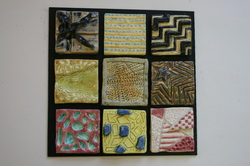
While creating my mug, I learned that a functional piece of art can also be artistic. My mug acts as both a piece of art, and a cup that I can drink out of. Throughout the course of this project I learned that creating a deeper incision looks more appealing than a minimal low relief incision. A random technical breakthrough I experienced while glazing was that the glaze runs when more than one glaze is used on the same area. I could use this technique idea in the future to create a really interesting glaze on a simple piece. I want to try and recreate a similar pattern that I used on my mug in our future projects. I hope to combine more high and low relief, however. I plan on possibly using geometric shapes, and harsher lines instead of flowing lines.
Trying to keep the rim of the mug straight and stay the same width on each side proved to be a struggle for me. Having the plastic cup helped maintain the shape of the mug throughout the building of the mug. I found it easiest to hold the mug from the inside, because I was putting so much pressure on the mug while carving out my design. In some areas I carved in too deep, so from the inside of the mug you can see a faint outline of the design that I carved. It frustrates me that you can see the design, but with the dark glaze I used on the inside it is concealed pretty well so that it is not too obvious. I don’t believe that anything in this project should have been altered. Making a mug is not a hard task, and the project guidelines should be kept the same in the future!
I could have improved the consistency of width of my mug. Throughout the process of designing my mug I must have put too much pressure in some areas so that it became extremely thin. To improve this in the future I will work on being gentler and being more aware of the thickness of the clay. So the area of the rubric that I need to focus on is craftsmanship. I feel like time and effort I put into this mug was my strength; also I feel that I challenged myself more than the tile project.
Trying to keep the rim of the mug straight and stay the same width on each side proved to be a struggle for me. Having the plastic cup helped maintain the shape of the mug throughout the building of the mug. I found it easiest to hold the mug from the inside, because I was putting so much pressure on the mug while carving out my design. In some areas I carved in too deep, so from the inside of the mug you can see a faint outline of the design that I carved. It frustrates me that you can see the design, but with the dark glaze I used on the inside it is concealed pretty well so that it is not too obvious. I don’t believe that anything in this project should have been altered. Making a mug is not a hard task, and the project guidelines should be kept the same in the future!
I could have improved the consistency of width of my mug. Throughout the process of designing my mug I must have put too much pressure in some areas so that it became extremely thin. To improve this in the future I will work on being gentler and being more aware of the thickness of the clay. So the area of the rubric that I need to focus on is craftsmanship. I feel like time and effort I put into this mug was my strength; also I feel that I challenged myself more than the tile project.

 RSS Feed
RSS Feed